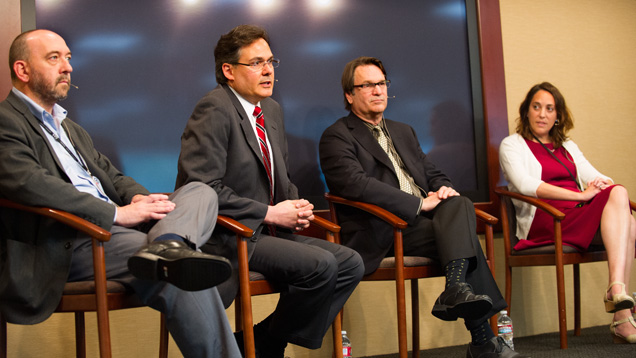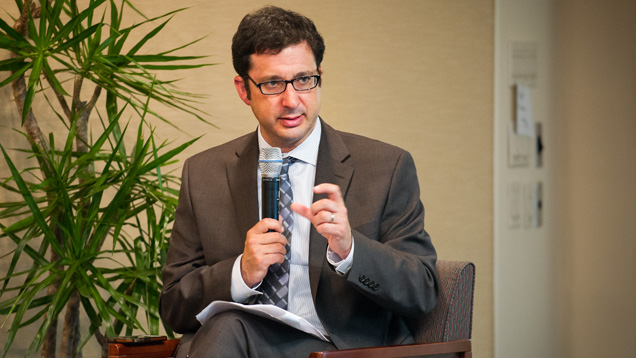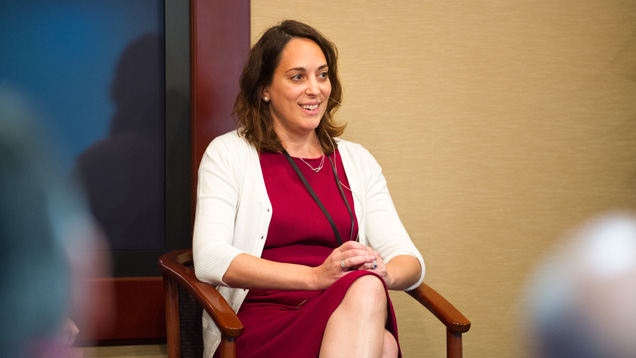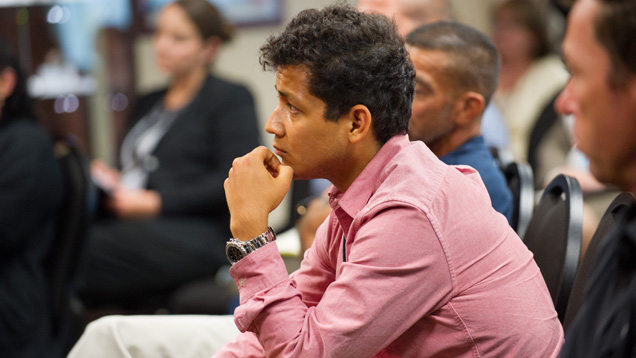Sorting Through the Complex Realities – and Opportunities – of Responsible Sourcing
July 10, 2015

Brad Brooks-Rubin, GIA’s global director of development and beneficiation, invoked lyrics from hip-hop artist Chance the Rapper as he welcomed GIA students, staff and invited guests to a panel discussion on responsible sourcing at the Institute’s Carlsbad campus in April.
“In this context, the idea of the truth not rhyming − or not being easy or fitting into an easy mold − works on two levels,” Brooks-Rubin said. “First, quite simply, there are problems in the supply chain that need to be addressed, just as there are in the supply chain of about any product in the marketplace … These issues are real, and they often very much do not rhyme.
“Second, there are solutions to these problems, but sometimes the solutions don’t rhyme, either … they are not simple or easy, and they require difficult choices and painful conversations.”

Moderator Brad Brooks-Rubin, GIA’s global director of development and beneficiation, admitted to the laughing audience and panelists that “as a former regulator and a former person working on the Kimberley Process, it’s taking all I’ve got not to comment myself.”
Brooks-Rubin, a former special advisor on conflict diamonds for the U.S. State Department, moderated the panel, which was part of a series of presentations for on-campus students that gives them an opportunity to hear first-hand from members of the gem and jewelry industry. Topics often address business tips for success and issues that are important in the trade.The Responsible Sourcing panel included David Bouffard, GIA GG, vice president of corporate affairs for Signet Jewelers Ltd.; Eric Braunwart, founder, president and CEO of Columbia Gem House; Beth Gerstein, co-founder and co-CEO of Brilliant Earth; and Stewart Grice, director of mill and refining at Hoover & Strong.
The panelists, who represent a range of the gem and jewelry industry’s supply chain sectors, geographical sourcing areas, and market and company sizes, fielded a variety of questions and discussed how regulations play out in the marketplace – and how, as Brooks-Rubin said – they navigate what can be “extraordinarily complex and downright overwhelming” issues.
The reasons and ways these companies came to focus on responsible sourcing varied as much as the ways they interact with the issues today.

Beth Gerstein, co-founder and co-CEO of Brilliant Earth, said her company’s mission is to practice social and environmental responsibility. “There’s a growing number of people who want their purchase to be more than the ring on their finger,” she said. “They want an authentic experience they can feel good about.”
Gerstein, who founded California-based Brilliant Earth 10 years ago, said the retailer’s mission is to practice social and environmental responsibility, and “give back a portion of our profits to communities that have been traditionally been harmed by the jewelry industry.” For Gerstein and her customers, who care deeply about an ethical supply chain, issues like fair wages for miners in West Africa are a big and ongoing concern.“We spend a lot of time looking at issues surrounding diamonds, and a lot of them are surrounding human rights abuses,” such as land seizures, violence and rape, she said. “That’s one of the blatant, horrific, eye-opening issues we want to protect our industry against, and protect consumers from having to buy a diamond that’s associated [with such abuses].”
Bouffard said the multinational Signet, whose U.S. stores include Kay, Zales and Jared the Galleria of Jewelry, isn’t driven to practice responsible sourcing because of consumer demand (“they don’t ask”), but because of the company’s place in the supply chain.
“In the mall, you [the customer] don’t think about supply chain issues, you’re thinking ‘that store brand must have taken care of this already,’” he said. “We think we are the largest purchaser of polished diamonds in the world; we think we are the largest retailer of diamond jewelry in the world. So we believe it’s incumbent upon us to take a leadership role when it comes to responsible sourcing.”

“We believe that voluntary initiatives of like-minded companies and organizations coming together – and governments coming together – to address issues are the way forward,” said David Bouffard, vice president of corporate affairs for Signet Jewelers Ltd., whose U.S. brands include Kay, Zales and Jared the Gallery of Jewelry.
Braunwart’s 37-year-old Columbia Gem House is a wholesale, retail, and primarily gem-cutting operation, that mines in six locations – three in sub-Saharan Africa, two in the United States, and one “off and on” in Australia. He said that several years ago they “started very diligently defining what we wanted to see in our supply chain and what we believed in … and started trying to find partners who believed in what we did.”Examining the supply chain meant Columbia needed to “look to the miners” − the vast majority are artisanal miners and farmers − and get directly involved in issues that mattered to them, like educational opportunities for their children. It also meant that the company would stop cutting certain stones, and start educating themselves on issues such as deadly silicosis in gem-cutting factories.
Grice, who directs mill and refining operations for Richmond, Virginia-based Hoover and Strong, said the century-old wholesale precious metal manufacturer made a dramatic move toward responsible sourcing several years ago.
“We saw a need in the market in about 2007 to have a transparent supply chain, and that’s when we took the decision to go for 100 percent recycled metals,” he said. The change put the company in a somewhat unusual position.
“We’re lucky that we have our own refinery, we have our own mill products division, and we have our own components and assembly division, so we can have total control of our supply chain.”
Brooks-Rubin also questioned panelists about the effectiveness of regulatory initiatives versus voluntary transparency, and what it takes to go past the “do no harm approach” into more proactive, engaged economic development.
Government-mandated regulations – at least in the way they often play out – did not generate much enthusiasm from the panel, though they admitted the jewelry industry is lagging in voluntary transparency.
Gerstein suggested that regulations like the Kimberley Process may be less effective in practice than initially intended.Times are changing, people now want to know where their goods are coming from .... We need to get our ducks in a row before consumers take their money and go buy electronics … instead of a piece of jewelry.
“The Kimberley Process is something that originally was founded to keep conflict diamonds from funding rebel groups,” she said. “At this point, I think it’s is a fairly watered-down version of what it’s supposed to be.”
Bouffard acknowledged that the Kimberley Process was “historic,” but its definition of conflict “is very myopic.”
“While we want to celebrate what the Kimberley Process has done,” he said, “we don’t think it’s gone far enough.” He said Signet, founding members of the Responsible Jewelry Council with GIA and other organizations 10 years ago, continues to advocate “for a change in the definition and other reform efforts” to the Kimberley Process, and is working on a “protocol for diamonds that is essentially voluntary.”
Braunwart said he hopes the industry would “get off the dime” and work toward voluntary transparency and responsibility. Columbia Gem House arranges community development groups of local people in each of the areas they work, but that even with locals helping to identify issues and suggest policies and procedures, things get complicated.
“You really have to look at it as the continual improvement model,” he said. “Don’t get discouraged.”

GIA audience members engaged in a lively question and answer session with panelists after the presentation concluded.
As the group discussed the cost and value of responsible sourcing on healthy business and for the consumer, a seeming consensus was reached: at the end of the day, it’s good for everyone.Gerstein, Bouffard and Grice all said their businesses have grown in spite of economic downturns and an increased focus on responsible sourcing.
“The value for us as a company was huge,” Grice said. “It worked extremely well. We actually went up in sales.”
Braunwart said consumers respond favorably when they’re given a compelling narrative. When retailers with Columbia’s colored stones present customers with three exactly matched stones – two of them with no background story and one in which the salesperson can relay the gem’s entire journey – the stone with the story has always been the one that sells, even when it’s priced five to 15 percent higher.
He admitted his company’s move toward ethically sourced stones has “financially been extremely difficult in some of the years,” but stressed its importance.
“This really is a personal commitment you’re making,” he said. “I believe it will add value to the product in the long run and make our industry better.”
About the Authors
Jaime Kautsky, a contributing writer, is a GIA Diamonds Graduate and GIA Accredited Jewelry Professional and was an associate editor of The Loupe magazine for several years.



